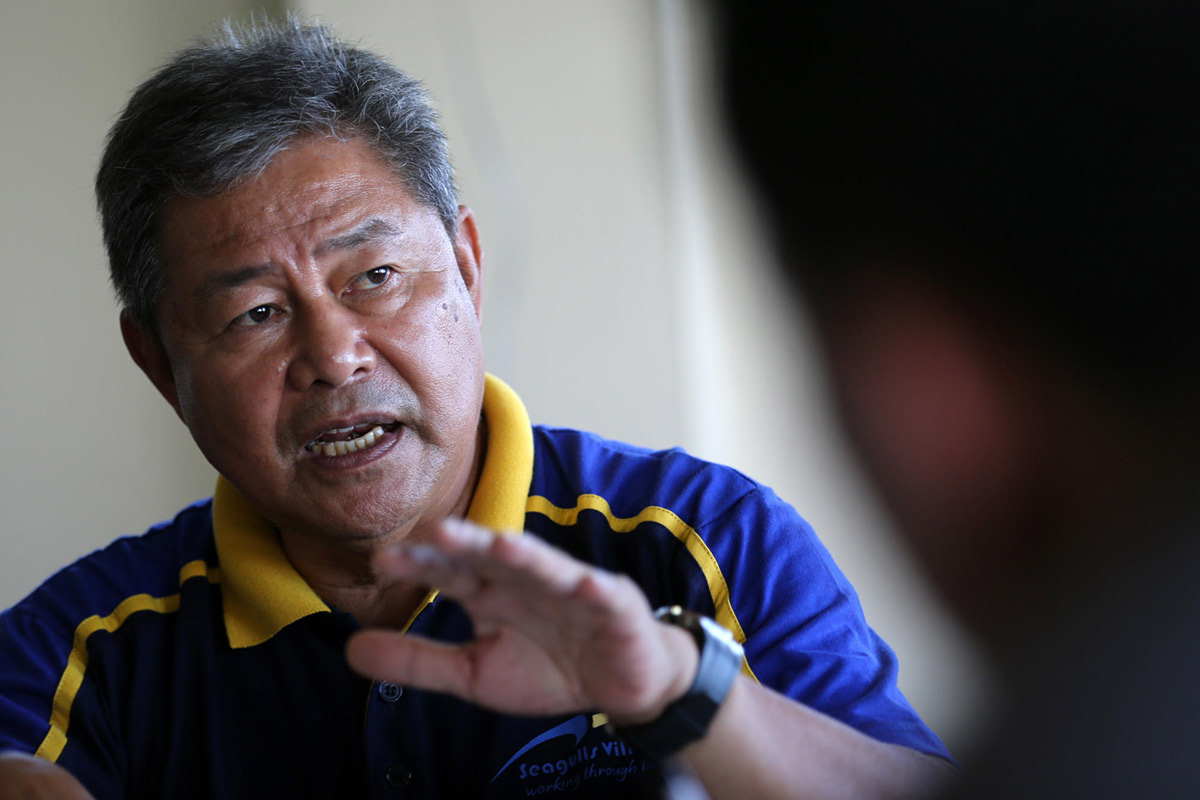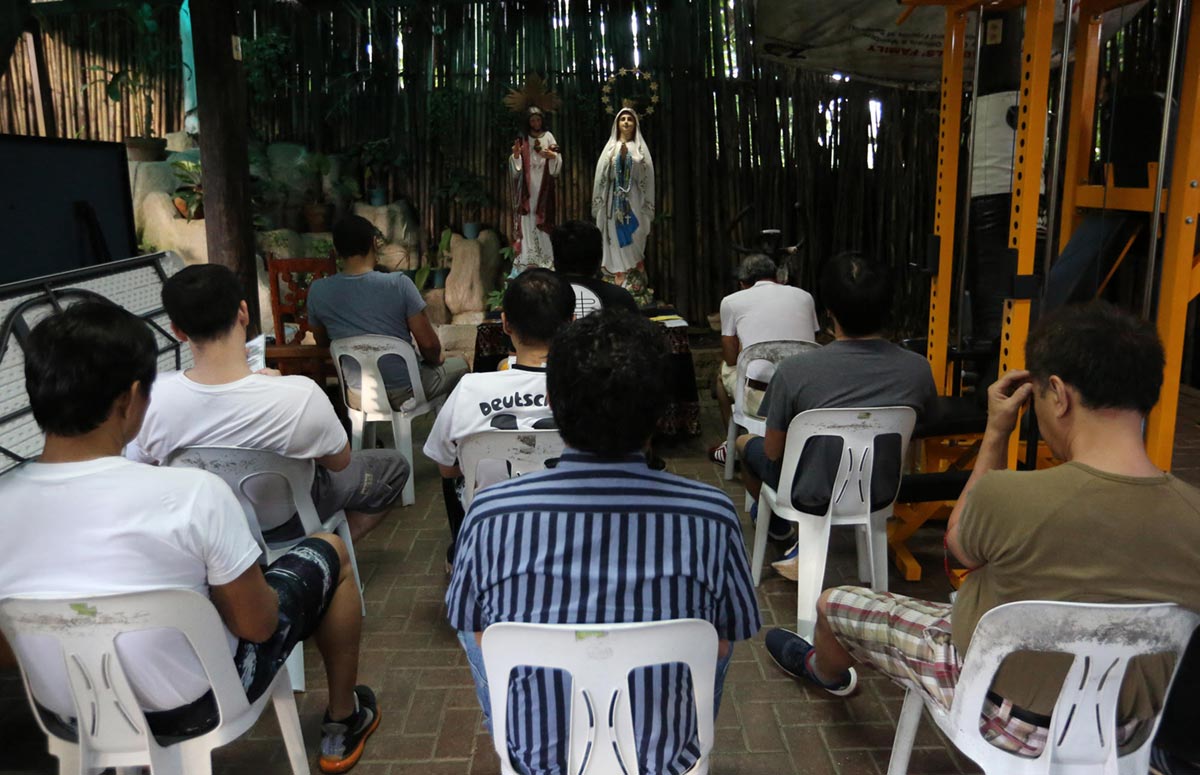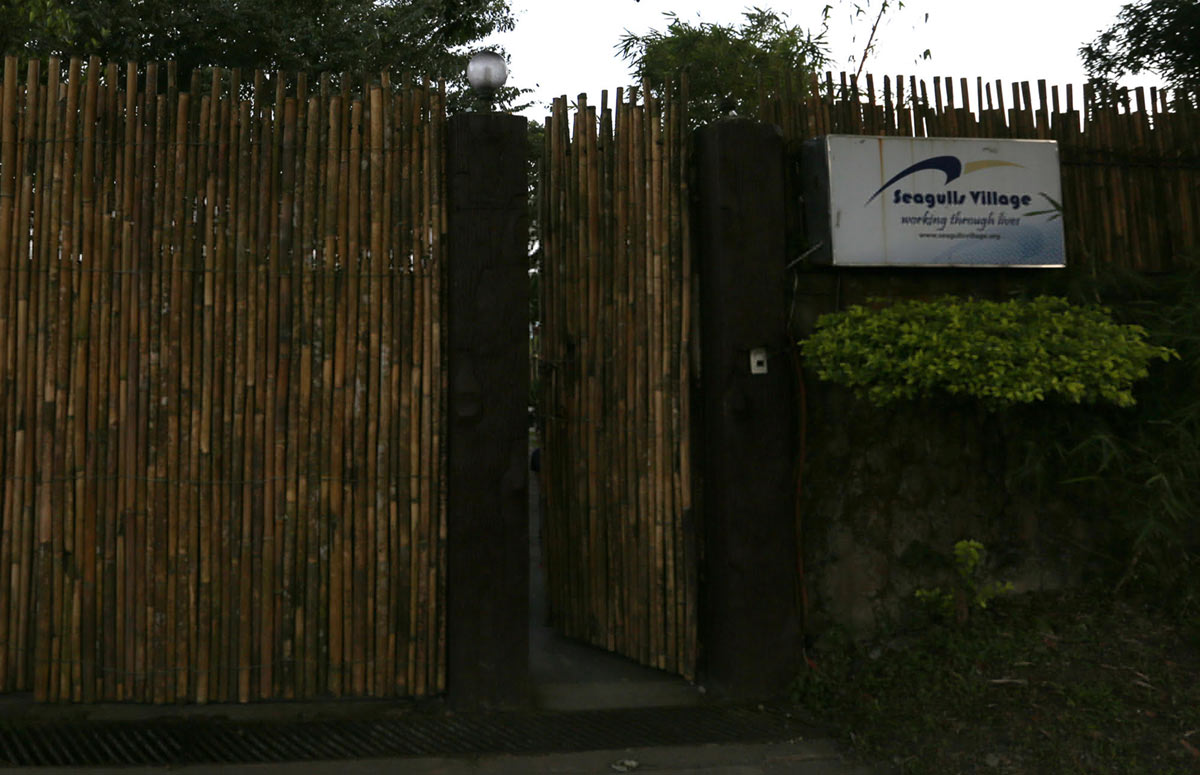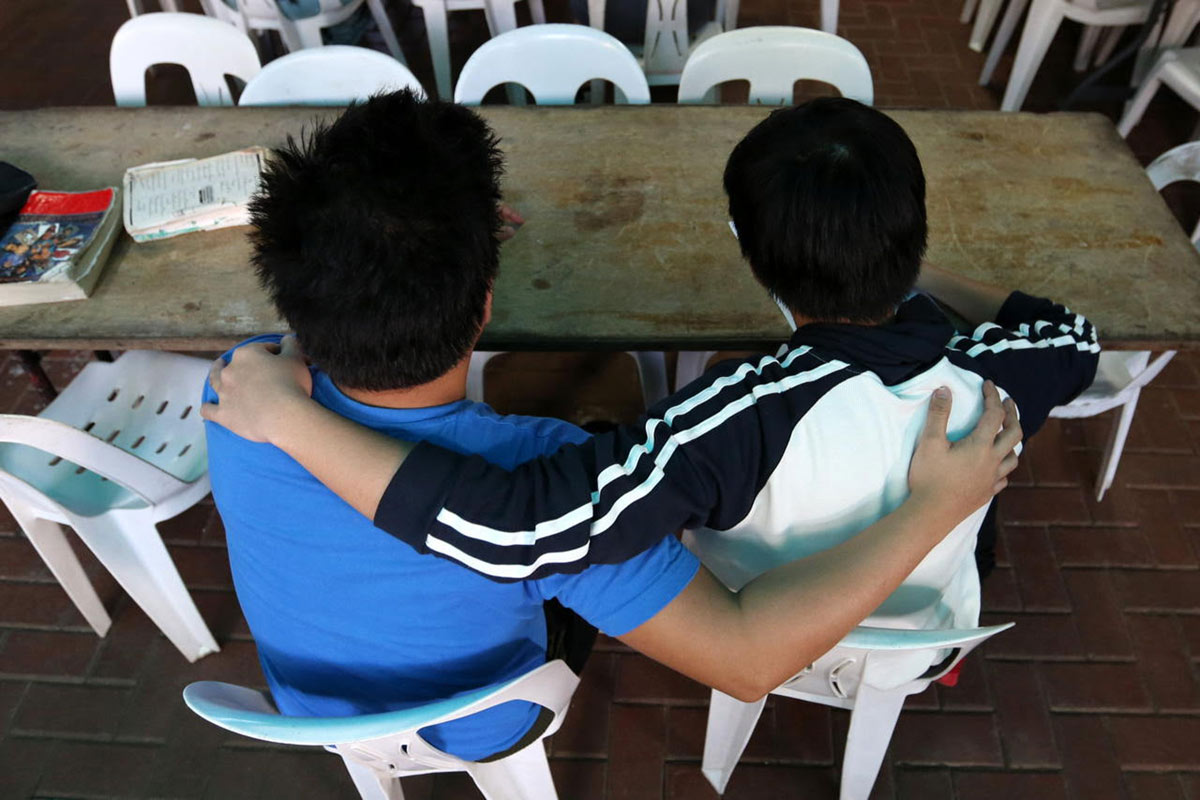Mayors, lawyers, celebrities and others who are hooked on illegal drugs go hiking and eat at a buffet everyday inside one of the country’s 27 private drug rehabilitation facilities. Inside the center for the wealthy who can afford proper treatment, patients are strictly monitored and taken cared of, in the hopes that they can one day integrate themselves back into society.
Four city mayors, celebrities and foreigners who were once former “shabu” and marijuana addicts had been patients at this rehabilitation facility located around 57.4 kilometers south of Metro Manila.
After 15 months, they were back—renewed and, it is hoped, useful to society.
These former patients call their place of healing in Tagaytay City, Cavite, the Seagulls Flight Foundation Inc., a residential facility for moderate to heavy drug users.
The name is inspired by the tale of Jonathan Livingston Seagull, an outcast seagull who dreamt of flying. Alone and resisting conformity, Jonathan Seagull found his purpose, learned about his strengths and weaknesses in isolation and, in the end, found joy and peace.
The one with the once broken wings learned to fly, soar high.
That remains primarily the goal for drug addicts, says Seagull founder and executive director Ed Castillo–redemption, not condemnation. Acceptance, not execution.

The private rehabilitation center was founded in 1998, and currently houses 50 patients who are usually from well-off families who can pay the tens of thousands of pesos in monthly fees. Such patients can come as far as from Jolo province in Mindanao.
One of its alumni patients, Eric, 52, is a lawyer who came from a family of judges and law professionals. At the height of his addiction, he had defended criminals, including drug users and pushers caught by police.
“I would look into lapses in the chain of custody, work around it, so I can get them acquittal,” he said. He also once lawyered and ushered clients to undergo rehabilitation, even if, at the back of his mind, treatment and rehabilitation for drugs was just a “backyard industry,” a money-making scheme.
Eric had for decades denying his drug addiction before voluntarily confining himself in March 2015.
“I needed help,” he said, recalling his years taking “shabu” and other substances. “That time, I was about to hit rock bottom in my drugs use.”
Eric had graduated law from Ateneo de Manila University and had been practicing for nine years when his then girlfriend introduced him to shabu in 1997. From becoming a light recreational drug user, he turned into a heavy drug dependent who was dysfunctional without drugs. During the height of his drug addiction, he could spend P6,000 on drugs in just one day.
Eric said things were manageable at first: “I did not believe in rehabilitation,” he said. “For me it was a no-no, since I will be out of circulation. I will be away from my family, from my wife for quite a long time. I told myself rehab is not for me. I can do it alone. I’ve said that a thousand times, over a thousand times, but I can’t just do it.”
But his addiction kept on coming back despite all his efforts. “I consulted the psychiatrist, the toxicologist, the psychologist. I was visiting them on a regular basis, attending counseling. To a certain degree, it helped. In fact, I stopped for quite some time…but here it goes again,” he said.
Eric finally reached a point when it finally dawned on him that his family and his work were already suffering. He became irritable; his values were changing. He used to work for 14 hours before; with his addiction, he was productive for only three hours. “I felt drugs were already stopping me; that my brain is flying away,” he said.
Until he went to the Seagulls.
For the first three months, Eric could not sleep. He would wake up late despite their 6 a.m. call-time. He found sleep only much later, when he was taught to focus and to not think too much about the outside world. He would later admit that he enjoyed his stay at the center–the confrontation, the opportunity to listen and to be heard.
Before long, Eric no longer craved the drugs that held him captive for decades of his life. Today, Eric is a living testament to what Seagulls can do for drug addicts who want to reform.

Away from the bustling city and situated at a higher altitude with trees surrounding the center, patients are expected to take things slowly a step at a time. The place, cool and uncrowded, gives a lot of breathing space for the patients.
Clients and facilitators called each other “Kuya” and “Ate”–big brother and big sister.
Inside the rehab, major no-no’s are sex, cellphones, chocolates, smoking, drinks and illegal drugs. Only certain type of books and magazines and television shows were allowed. The goal is not to induce any craving or distraction to the patient. When residents start to flirt, for example, other patients immediately call them out.
Dr. Alfonso Villaroman, an addiction specialist and director of the government-funded Department of Health-Treatment and Rehabilitation Center in Bicutan, likes such feelings of attraction to a brain disease.
“It affects a part of your brain. Getting used to euphoria for a long time, dopamine, the tendency is to crave. The only way to normalize it is total abstinence,” he said.
At Seagulls, residence psychiatrists cater to those with mental illness like ADHD, depression and bipolar disorder, among others.
Most of Seagulls' clients come from a family of lawyers, celebrities, businessmen, engineers and politicians, which explains the “very strict” confidentiality clause during visits.
“You can’t show their faces,” founder Castillo had warned the Inquirer during its visit. “We will get jailed.”
Private centers like Seagulls cost around P50,000 per person per month. In a year, that’s a steep P600,000 or so admission fee.
It’s easy to see, however, where the money goes. Clients are served food buffet-style. The center has its own nutritionist and monitors patients’ food intake; no extra rice for those who need to lose weight. Patients sleep in air-conditioned bedrooms for either five or 12 people. There are no private bedrooms in the facility, as it’s risky to leave them alone.
Because only the very few can afford treatment, Seagulls subsidizes patients, Castillo said. Sometimes, there are special cases where clients are admitted for free.
Currently, Seagulls is one of the 27 privately managed residential centers in the country. According to the recent data from the Dangerous Drugs Board, there are only 15 government-owned and three local government-owned centers in the country, including the ones in Payatas, Quezon City; Tugbok District, Davao and Magdalena, Laguna. There are 44 DOH-accredited residential TRCs, three of which are outpatient.
Since President Duterte assumed office on June 30, the DOH has already allocated in its 2016 budget around P900 million for TRCs, and plans to build four new rehabilitation centers with 2000 bed capacity each.
At Seagulls, patients are presumed safe. All forms of sinners are welcome, but they are compelled and trained to cease from sinning.
Moral recovery is very important at the center, former patient Eric recounted. “It’s very beautiful how someone like me, who has no rank, can give an advice to another person, that someone listens and values my opinion. In here, like family.” he said.
Patients either voluntarily bring themselves to the facility or someone else compels them to.
Seagulls' youngest patient in its history is 16-year-old "Ken"; the oldest is aged 64.
Ken, a marijuana and “shabu” drug user, was tricked by his parents into delivering flowers from their shop in Dangwa, Manila, to the rehabilitation facility in Tagaytay City. He has since been locked up in the facility.
Before the treatment, all patients are sent to a private hospital for detoxification. This works well, especially to those who experience withdrawal syndrome. Patients are said to be clean upon arrival in the facility. They also undergo several psychological battery exams.
Patients are then given primary treatment at Seagulls for six months. During the first four months, they are prepared to hold their first dialogue with relatives. While the patient is undergoing treatment, family members also have their weekly and follow-up support group with psychologists in another office manned by Seagulls in Alabang, Muntinlupa.
If the family is abroad, sessions are done via Skype. “Our family program is very important. Clients who complete all phases have higher success rates and lower chances of relapsing,” Castillo said.
After the first six months, clients then undergo another 10 months of therapeutic community counseling. The time after that will be a gradual reintegration to the family, to the community—starting from eight hours, then 12, 24 and 48 until exposure happens once, twice a week. This is the time when patients are given days off to go outside under the close monitoring of the staff.

Although strictly locked up, time passes by fast in Seagulls due to patients’ rigid schedules.
At 5:30 a.m., clients are woken up and made to pray, eat and do their assigned tasks for the rest of the day, which includes cleaning the facility.
Seagulls, like most treatment facilities, uses the therapeutic community approach in dealing with patients.
“The atmosphere is therapeutic. We do therapeutic community. We do mirroring. It’s tough love as they say,” Castillo said. “But there is no violence; this is not a jail. There are no threats.”
This approach allows patients to be conscious of their actions, learn how to confront their problems well and, later on, admit their mistakes, Castillo added.
READ: LGUs, private sector partner for community-based drug rehab programs
Clients, who are dressed in all white during their stay, are also required to submit to authorities, respect people and reflect everyday through journal writing. At the mess hall, an altar of a religious Catholic figure watches over the patients while they write on their journals.
Among the techniques used in this approach is “confrontation,” in which residents are noticed and called out for every fumble or little mistake they commit at the center. Every fumble will be magnified—a lousy shirt, forgetting to greet visitors or even bad handwriting. Having someone notice and watch over you and call you out may seem weird to outsiders, but patients have to listen, yield and apologize.
More fumbles mean more sanctions, like a harder task or–worse–extended rehab time. The longer and more submissive one becomes, the higher his rank gets.
“Practically, we heal their bruised ego here,” says Castillo. “During the sessions, we ask the patients to verbalize their fear and pain, and then we talk about the program so they can process it,” Castillo said.
All of Seagulls' staff members are certified addiction specialists who are trained with the “Colombo Plan” at the International Center for Certification and Education of Addiction Professionals. “The program is originally from the United States, but it was redesigned to suit the Asian and Filipino culture,” Castillo said.
John, an alumnus who used to sell illegal drugs, now works as a staff worker. “At first, I tried to escape from the facility because I simply wanted to go out.”
Now, his role is to record the wrongs of his every patient to help them correct it.
Among the programs that set Seagulls apart from government rehabilitation centers is its individualized treatment plan, group sessions, psychological education and evaluation. All patients need to secure a court order prior to admission.
Among past sports activities are mountain climbing in Mt. Maculot, Pico de Loro and trail biking in Nuvali, Laguna.
The most extravagant, perhaps, are trips abroad. This October, patients are set to go to Malacca to attend a conference about illegal drugs. At Seagulls, patients attend conferences about addictions so they can later work for the center. “This is the part of their credentials that will soon lead to certification,” he added.
Seagulls also has tie-ups with Alcoholics Anonymous and Gamblers Anonymous, since the center also caters to drunkards and gamblers. Under an existing partnership with Tahanan, Quezon City’s treatment and rehabilitation center, Seagulls also trains the city’s antidrug abuse council to do community-based rehabilitation programs.
READ: Rehab or Rubout Part 2

Seagull’s treatment plan may be sold, but it does not guarantee a 100-percent success rate. In fact, no treatment can. According to DOH data, the average relapse rate for drug dependents is around 20 percent. The success rate mostly depends on the facility’s aftercare program, once patients are feeling more like their former selves.
This is why Seagulls focuses not only on the patient but also on the family that welcomes back him or her after the treatment.
Such a method has been proven to work, for the most part. Four of Seagulls' staff members are even alumni of the center. Four former patients even became mayors of their own cities after their stint at the treatment center.
“These people come from a family of politicians. After they finished, they won. These were ‘shabu’ addicts for years but they recovered,” Castillo said. “When they tell us that these people who are into shabu for six months are beyond recovery, it’s very sad. Based on our experience, it’s not.”
“That should not justify the [recent] killings,” he added.
READ: ‘Junkies are human’–Duterte
And Castillo is one to talk. He, too, in fact, is also a living testament of what proper treatment and rehabilitation can do. The center’s founder has been sober for 43 years; he was once addicted to LSD and marijuana.
“The center involves moral recovery. As a drug user, I lost my values. I was a very manipulative person. An addict is a liar. We tend to give a lot of excuses and make all sorts of deception and manipulation. We are irresponsible,” he said. “But here, we are taught the opposite. Whatever was lost to us when we became addicts are restored here–whether we like it or not.”
Castillo, however, conceded to the fact that there could really be a point of no return for drug dependents. But medication could help.
For Seagulls’ alumnus and staff member John, drug addiction is still an everyday battle. Being clean is only a matter of time.
“I can say I am clean now,” he said. “Now. Tomorrow, maybe, I still don’t know yet.”
But for lawyer Eric, his stay made him feel accepted, safe and loved. These feelings, he hoped, would help prevent him from relapsing.
“I would just look at the sky, and the trees and I feel like I am ready to go outside. That these few months I am staying will prepare me for the outside,” Eric recounted, who started serving as one of the center’s legal counsel after being released in June 2015.
Advises Eric: “The best way to prevent relapse is to find accountability partners or support group after the treatment. The value of an addict helping another addict is without parallel.”
READ: Rehab or Rubout Part 1
READ: Rehab or Rubout Part 2
READ: Rehab or Rubout Part 4
Note: Three months after President Duterte first announced his all-out war on drugs, former and current drug dependents are faced with only two choices: be rubbed out by either police or vigilantes, or be rehabilitated by centers and doctors ill-prepared to cater to the overwhelming influx of drug surrenderers. The Inquirer shines a light on the latter choice in a four-part special report running from Oct. 6 to 10.